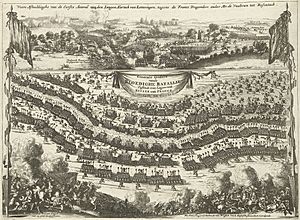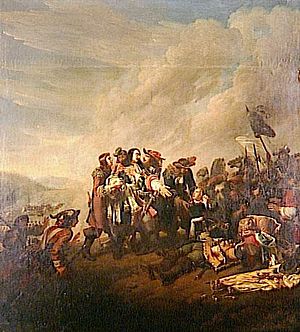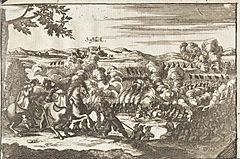Battle of Salzbach facts for kids
Quick facts for kids Battle of Salzbach |
|||||||
|---|---|---|---|---|---|---|---|
| Part of Franco-Dutch War | |||||||
 Battle of Salzbach (c. 1675) |
|||||||
|
|||||||
| Belligerents | |||||||
| Commanders and leaders | |||||||
The Battle of Salzbach, also called Sasbach, happened on July 27, 1675. It was part of the Franco-Dutch War. In this event, a French army led by Marshal Turenne faced an army from the Holy Roman Empire commanded by Raimondo Montecuccoli. The "battle" was mostly a fight between their cannons. During this artillery duel, Marshal Turenne was sadly killed by a cannonball.
Contents
Why the Battle Happened
The Franco-Dutch War Begins
The Franco-Dutch War started in May 1672. French troops quickly took over much of the Dutch Republic. They had help from the English navy. By July, the Dutch managed to hold their ground. Other countries like Brandenburg-Prussia, Emperor Leopold, and Charles II of Spain became worried about France's gains. They decided to help the Dutch. In August 1673, an Imperial Army entered the Rhineland. France's king, Louis XIV, had to fight on many fronts. So, he gave up most of his gains in the Netherlands to focus on other areas.
Changing Sides and Key Victories
In January 1674, Denmark–Norway joined the group fighting against France. A peace treaty in February 1674, called the Treaty of Westminster, ended the Third Anglo-Dutch War between England and the Dutch. After France took back Franche-Comté in June, their main army, led by Condé, won a close victory. This was against a combined Dutch-Spanish force led by William of Orange at the Battle of Seneffe in August. But France lost so many soldiers that Condé was told to stay on the defensive.
Turenne's Success in Germany
French forces in Germany were led by Turenne. From 1673 to 1674, he won many battles. He defeated larger Imperial forces led by Alexander von Bournonville and Raimondo Montecuccoli. People at the time thought Montecuccoli was the only commander as good as Turenne. The campaign that started in June 1674 and ended with Turenne's death in July 1675 was very impressive. Even though he had fewer soldiers, Turenne fought Bournonville to a standstill at Entzheim in October. Then, he won a big victory at Turckheim in January 1675.
The 1675 Campaign Begins
After Bournonville's defeat, Montecuccoli took charge of the Imperial forces in southern Germany. He wanted to make up for the recent loss. He planned to cross the Rhine River at Strasbourg and take back Alsace. In the spring of 1675, he marched west through the Black Forest into the Rhine valley. There, he gathered the remaining 8,000 soldiers from Bournonville's army. The Imperial army now had 18,000 foot soldiers and 14,000 horsemen. On May 20, Montecuccoli set up his main camp at Willstätt. His scouts reached Kehl, a town on the east bank of the Rhine, across from Strasbourg.
A Game of Cat and Mouse
As Montecuccoli got close to the Rhine, Turenne and his army moved to stop him. Turenne had 20,000 foot soldiers and 15,000 horsemen. Turenne sent a message to Strasbourg, which was an independent city then. He demanded that the Imperial army not be allowed to use the city's bridge over the Rhine. But Strasbourg favored the Empire. So, the city let Montecuccoli cross on May 22. They even sent him special foods. Montecuccoli seemed a bit scared by Turenne's approach. Even though he crossed the Rhine, he didn't bring his whole army with him. He pretended to move troops to Kehl, but soon he and his army marched north to try crossing somewhere else.
On May 31, Montecuccoli crossed to the west bank of the Rhine near Speyer. But this was just a trick to make Turenne move north, away from Strasbourg. The Imperial army pulled back to the east bank on June 4. Turenne wasn't fooled by this trick. The French army started building temporary bridges across the Rhine at Ottenheim, south of Strasbourg, on June 6. By June 8, the French were across. Now both armies were on the east bank. Like Montecuccoli, Turenne chose Willstatt for his main camp. The Imperial army quickly moved south to face the French, who were now blocking the way to Kehl and Strasbourg. The Imperial advance group, 4,000 men under Charles of Lorraine, attacked the French lines but were pushed back.
More Tricks and Waiting
Montecuccoli tried another trick to draw Turenne away from Kehl. He marched around the French eastern side, near the Black Forest, to take Offenburg. He sent troops even further south to threaten the French bridges at Ottenheim. Turenne refused to fall for it. He simply moved his bridges north, closer to Willstatt. For a week, the two armies watched each other. Neither side wanted to start a big battle. Finally, Montecuccoli's army ran out of food for their horses. He had to pull back north to dig in his army along the Rench River, 10 miles from Strasbourg. He left 5,000 men under Count Aeneas de Caprara to hold Offenburg. In response, Turenne moved most of his army to face the new Imperial position. He kept some soldiers in Willstatt.
Both armies had problems with supplies and the weather. French horses had to eat leaves, and the soldiers suffered in constant rain. While they waited for better weather, Turenne had a close call. Peasants shot at him and some French officers. They killed a guard standing near Turenne. The rain stopped on July 22. Turenne began a turning move to trap Montecuccoli against the Rench River. The French advance group attacked the Imperials at Gamshurst but was driven back. Montecuccoli tried his own attack on July 23–24, but fog made it hard. There was more fighting on July 25–26. Seeing no hope of winning along the Rench, Montecuccoli ordered a retreat into the Black Forest. He told Caprara to leave Offenburg and join the main Imperial army.
The Fight at Salzbach
Turenne followed the Imperial army. By this time, both armies had about 25,000 soldiers. On the morning of July 27, the French found the Imperial army digging in around the village of Salzbach. They were behind a stream of the same name, on a small plain at the foot of the mountains. The Imperial supply wagons could be seen moving into the pine forest beyond the village. Montecuccoli used hedges and woods to protect his troops. He placed musketeers (soldiers with muskets) in the village church and an old castle on his right side. The Imperial commander had to hold this spot because he was waiting for Caprara to join him. Caprara was slow because the French army forced him to take a long detour through the hills.
The French army lined up south of the Salzbach Stream. Their foot soldiers were in front, and cavalry (horsemen) were behind. Turenne sent Pierre de Mormez, his artillery general, to figure out the best place for the army's cannons. French volunteers went forward to shoot at the closest houses in the village. Eight French cannons were brought up to fire at the church and castle. Part of the village caught fire. But the French cannons were not very effective against the church and castle. This was because the Imperials had built defenses in the churchyard and cemetery to protect the buildings. Imperial cannons fired back, and a cannon duel began. Turenne sent a message to King Louis saying he planned to attack the Imperials if they started to retreat. The French marshal talked with his generals. He seemed sure they would win. The French could see a lot of movement among the Imperial units, which suggested they were unsure. The enemy looked like they were about to pull back.
Turenne's Death
Around 2:00 p.m., Saint Hilaire asked Turenne to check a cannon position. This position was meant to stop fire from Imperial cannons led by Margrave Hermann of Baden-Baden. A staff officer warned Turenne to be careful because of the dangerous enemy cannon fire. Some people think the fire was especially heavy because Saint Hilaire wore a red cloak, which made him an easy target. One story says Turenne agreed to be careful. He reportedly said, "je ne veux pas être tué aujourd'hui" ("I do not want to be killed today."). As the marshal and the general talked, an Imperial cannonball hit them. It took off Saint Hilaire's left arm and went through Turenne's body from his shoulder to his side. Turenne took two steps before he fell, but he didn't say anything. Saint Hilaire survived, but Turenne died instantly.
At first, the French tried to hide that their commander was dead. Meanwhile, Montecuccoli was surprised that a full battle hadn't started by mid-afternoon. He soon learned of Turenne's death, maybe from a soldier who ran away from the French side. He is said to have declared: "Today died a man who did honor to mankind."
After the Battle
French Retreat
When news of Turenne's death spread through the French army, there was sadness, confusion, and anger. The soldiers, especially the foot soldiers, loved the old marshal. Some said: "Notre père est mort, mais il faut le venger." ("Our father is dead, but we must avenge him."). Guy Aldonce de Durfort de Lorges, who was Turenne's nephew and a general, took command. Another officer argued with him for a short time. The French cannons kept firing. But soon it became clear that there would be no major battle. On the night of July 29–30, the French army retreated in an orderly way. A volunteer with the army later said that Turenne's battle plan died with him. He also said that the generals who took over were only praised for safely getting the army back across the Rhine. They then waited for orders from the king.
Montecuccoli's Pursuit
Montecuccoli pushed hard on the French as they left. It's not clear why he didn't attack on July 27 as soon as he heard of Turenne's death. His army was set up to defend against Turenne. So, he might not have thought it was ready to attack. Once the French were retreating, Montecuccoli felt strong enough to attack. He caused a sharp fight at the Schutter River. But he could not stop the French from crossing into Alsace.
The Battlefield Today
Turenne fell in what is now the small town of Sasbach, Germany. A monument stands near the spot where Turenne died. The Turenne-Museum is also nearby.
Images for kids




